Llansteffan is a picturesque village which sits about seven miles south of Carmarthen, just above the junction of the Taf and Towy estuaries. The village is overlooked by its fine 12th Century Norman Castle, and was once a thriving fishing community. There were at one time six places of worship in and around Llansteffan, one of which, Moriah Methodist Chapel, contains a memorial plaque to three former members who fell during both World Wars. Many thanks are due to Eiluned Rees of the Llansteffan Historical Society for her kind help in taking photos of the War Memorials and War Graves in the locality.
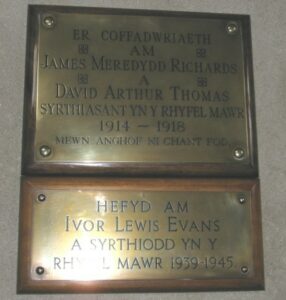
The Great War, 1914-1918
James Meredith Richards, Private, 16609, West Riding Regiment. James was the Son of James L. Richards and Ada Janet Richards, of Pantyrathro, Carmarthen. He was educated at Llandovery from 1911 to 1912, and then was in business in London. In September 1914 James enlisted in the Army at Cardiff, and joined the Dragoon Guards, but was invalided home with a leg wound, and spent some time in Hospital at Manchester. On recovering from his wound, James transferred Regiments, joining the 2nd Battalion, Duke of Wellington’s (West Riding) Regiment. The Battalion was attached to 12 Brigade, 4th Division, and by the time James joined them in July 1916, they were in positions on the Somme, where they fought at the Battle of Albert and the Battle of Le Transloy. On 15 December 1916 the Battalion relieved the Essex Regiment in the front line at Bapaume, in atrocious weather conditions. It is believed that James was killed by a sniper there, on 19 December 1916. He was 22 years old, and is buried at Sailly-Saillisel British Cemetery, France. James is also commemorated on the new memorial at Llanybri.
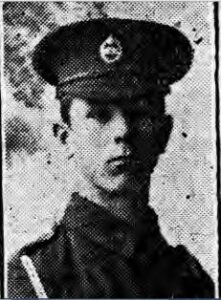
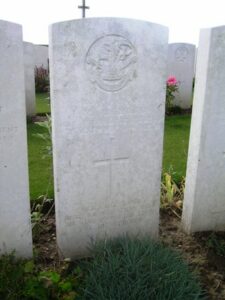
David Arthur Thomas, Second Lieutenant, Royal Welsh Fusiliers. David was the son of the Reverend David E. Thomas and Jennie Thomas of Brynllwyfen, Llansteffan. Prior to the war, David worked on the staff of Lloyds Bank in Llanelli, and enlisted into the Welsh Regiment at sometime in 1915. He was commissioned from the Welsh into the Royal Welsh Fusiliers, and after his training was posted to the 1st Battalion, Royal Welsh Fusiliers. He joined the battalion in France on 23 January 1917, where it was at Arras attached to 22 Brigade, 7th Division. The Battle of Arras began on 9 April 1917 and the 7th Division was moved in front of one of the most strongly defended German positions around Arras, at Bullecourt, which they attacked and successfully took alongside the Australian Corps. David was killed in action here during the attempted consolidation of a captured section of the Hindenburg Line north of Bullecourt on 4 May 1917, aged only 22. He is remembered on the Arras Memorial, France.
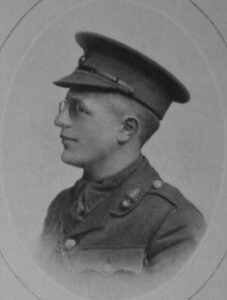
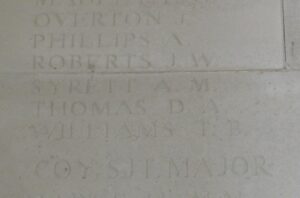
World War Two, 1939-1945
Ivor Lewis Evans, Private, 14541568, Cheshire Regiment. Ivor was born in the Llansteffan area, and served in the 6th Battalion, the Cheshire Regiment, which was created from a doubling up of the Territorial Army at the outbreak of WW2. The 6th Battalion was part of the 56th Division, who were moved from North Africa to take part in the Italian Campaign. On 3 September 1943, the Allies invaded the Italian mainland. Following the fall of Rome to the Allies in June 1944, the German retreat became ordered and successive stands were made on a series of defensive lines. In the northern Appenine mountains the last of these, the Gothic Line, was breached by the Allies during the Autumn campaign and the front inched forward as far as Ravenna in the Adratic sector, but with divisions transferred to support the new offensive in France, and the Germans dug in to a number of key defensive positions, the advance stalled as winter set in. Coriano Ridge was the last important ridge in the way of the Allied advance in the Adriatic sector in the autumn of 1944. Its capture was the key to Rimini and eventually to the River Po. German parachute and panzer troops, aided by bad weather, resisted all attacks on their positions between 4 and 12 September 1944. On the night of 12 September the Eighth Army reopened its attack on the Ridge, with the 1st British and 5th Canadian Armoured Divisions. This attack was successful in taking the Ridge, but marked the beginning of a week of the heaviest fighting experienced since Cassino in May, with daily losses for the Eighth Army of some 150 killed. Ivor was Killed in Action at Coriano Ridge on 18 September 1944, aged just 21. He is buried in Coriano Ridge War Cemetery, Italy. Ivor is also commemorated on the new memorial at Llanybri.